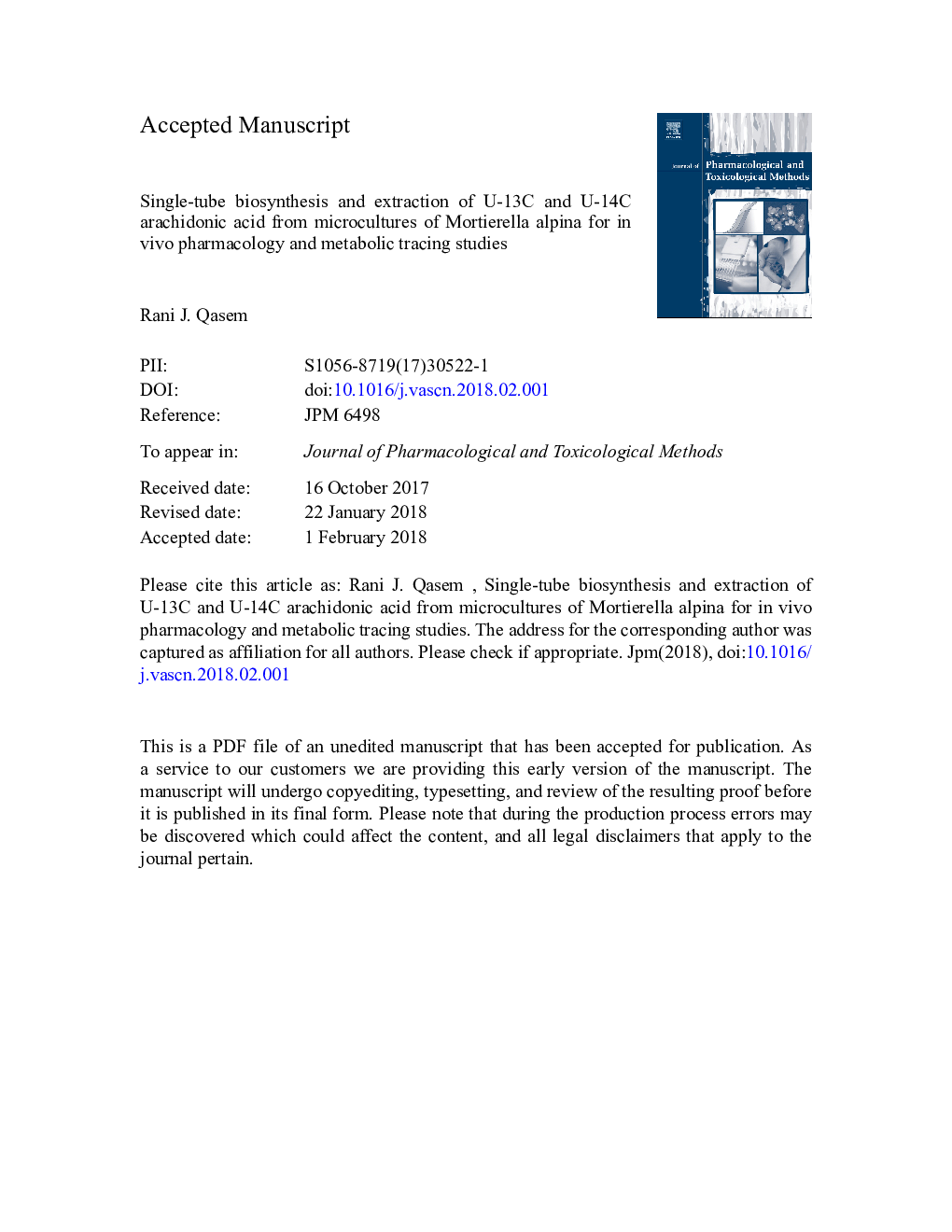| کد مقاله | کد نشریه | سال انتشار | مقاله انگلیسی | نسخه تمام متن |
|---|---|---|---|---|
| 8533771 | 1560471 | 2018 | 47 صفحه PDF | دانلود رایگان |
عنوان انگلیسی مقاله ISI
Single-tube biosynthesis and extraction of U-13C and U-14C arachidonic acid from microcultures of Mortierella alpina for in vivo pharmacology and metabolic tracing studies
دانلود مقاله + سفارش ترجمه
دانلود مقاله ISI انگلیسی
رایگان برای ایرانیان
کلمات کلیدی
EPAPSAQLLEETAdpmIRMSArachidonic acid - اسید آراشیدونیکStearic acid - اسید استئاریک Oleic acid - اسید اولئیکEicosapentaenoic acid - اسید ایکوزاپنتانوئیکEicosatrienoic acid - اسید ایکوزیتروئینیکdocosahexaenoic acid - اسید داکوزاگزوائونیکLinoleic acid - اسید لینولئیکMyristic acid - اسید مریستیکPolyunsaturated fatty acids - اسید چرب اشباع نشدهPolyunsaturated fatty acid - اسید چرب غیر اشباعPUFA - اسید چرب چند غیراشباعdisintegrations per minute - تخریب در دقیقهDHA - دوکوساهگزائنوئیک اسیدIsotope ratio mass spectrometry - طیف سنجی جرم نسبت ایزوتوپLoA - مجازاتMortierella alpina - مرتییرلا آلپیناstable isotope labeling - نشانه ایزوتوپ پایدارPalmitic acid - پالمیتیک اسید
موضوعات مرتبط
علوم پزشکی و سلامت
داروسازی، سم شناسی و علوم دارویی
داروشناسی
پیش نمایش صفحه اول مقاله

چکیده انگلیسی
Heavy and radioisotope labeling are commonly used methods to trace the pharmacological activity and metabolic fate of a biochemical or pharmaceutical in vivo. Recent years witnessed increased demand for molecules uniformly labeled with heavy carbon-13 (U-13C) or radioactive carbon-14 (U-14C) isotopes over singly labeled isotopic versions. Polyunsaturated fatty acids (PUFAs) represent one classic example where uniform 13C or 14C isotopic enrichment of the hydrocarbon backbone has numerous technical, metabolic and pharmacological advantages. PUFAs are usually produced in fungi or algae and uniform 13C or 14C enrichment of the hydrocarbon chain is achieved by feeding the microorganism a suitable U-13C or U-14C substrate. Previous literature methods describing the biosynthesis of U-13C or U-14C fatty acids reported variable isotopic enrichments that were less than anticipated and suffered from inconsistent growth of the microorganism due to radiotoxicity. In the present study, a single-tube method is described for the biosynthesis and extraction of U-13C and U-14C arachidonic acid (AA), a standard PUFA, from microcultures of the soil fungus Mortierella alpina. To produce U-13C-AA, a suspension of fungal spores and mycelial fragments was directly inoculated and grown into submerged cultures in a medium composed of U-13C-glucose and NaNO3 as the respective and only sources of carbon and nitrogen. The total 13C enrichment of AA was in excess of 95% and the percentage of U-13C-AA was in the range of 60-70%. These values have not been surpassed by previously reported methods. To produce U-14C-AA, the procedure was modified to limit the radiotoxic effects of 14C on fungal growth. Submerged cultures were initially grown on common 12C-glucose. Then, following glucose depletion, the biomass was collected and immediately cultured on U-14C-glucose. This approach is unprecedented in reported literature and has significantly limited the radiotoxic effects of 14C on the microorganism. Biomass transfer from 12C to 14C substrates was timed to keep an uninterrupted supply of carbon required to sustain the microorganism in the fatty acid synthesis mode and suppress β-oxidation, a metabolic status that is prerequisite for enhanced isotopic purity of the 14C product. The specific activity of 14C enriched AA was estimated at 864â¯Ci/mol (range of 708-1020â¯Ci/mol) suggesting 69.2% (range of 56.7-81.7%) 14C enrichment along the AA hydrocarbon backbone. The present method used a single tube for microbial culture and lipid extraction to minimize manipulative losses and oxidative degradation of the labeled products. Production cost is comparatively cheaper to custom labeling and yields of U-13C and U-14C-AA are comparable to literature methods and sufficient for small scale in vitro and in vivo pharmacological studies.
ناشر
Database: Elsevier - ScienceDirect (ساینس دایرکت)
Journal: Journal of Pharmacological and Toxicological Methods - Volume 92, JulyâAugust 2018, Pages 1-12
Journal: Journal of Pharmacological and Toxicological Methods - Volume 92, JulyâAugust 2018, Pages 1-12
نویسندگان
Rani J. Qasem,